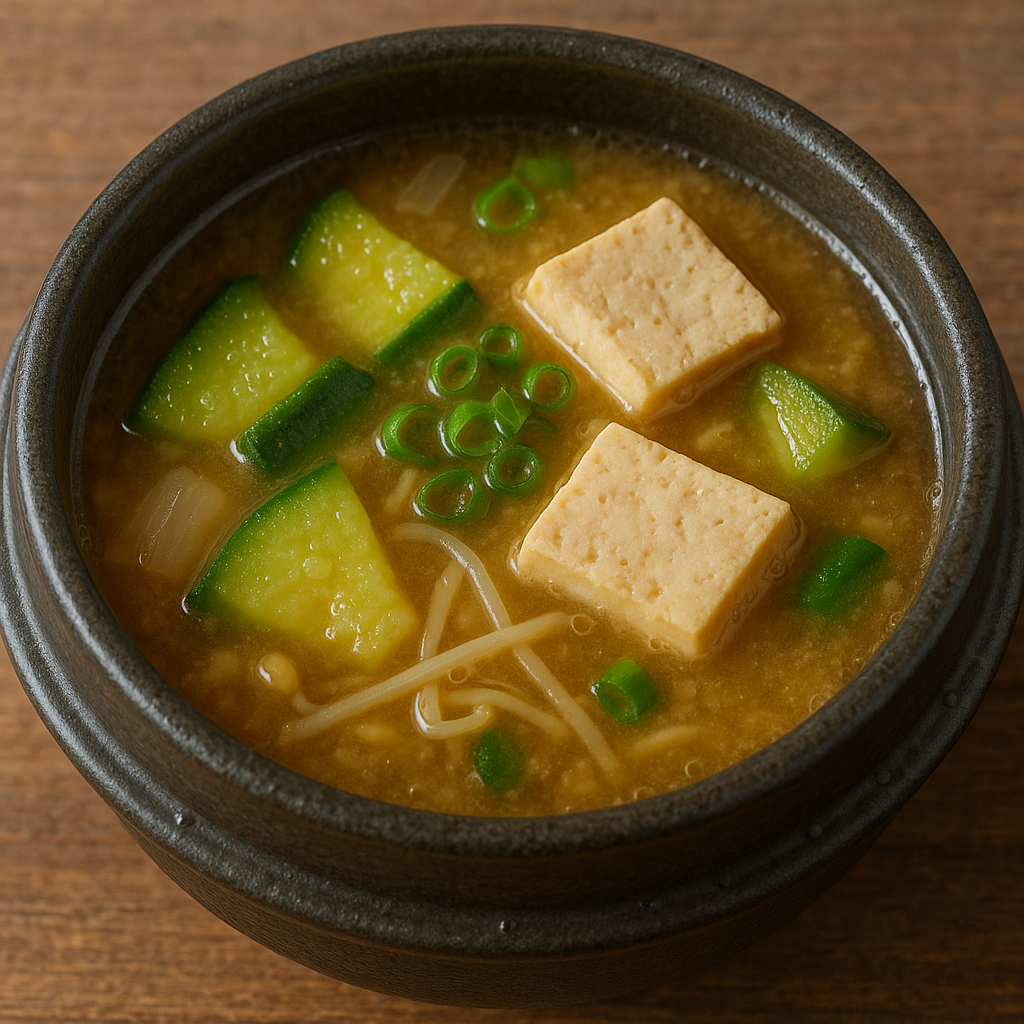🧡 A Stew That Tastes Like Home
Some dishes don’t need fancy presentation or complicated techniques—they just need heart. For me, doenjang jjigae (된장찌개) is exactly that. A bowl of warm, deeply savory stew that instantly takes me back to my childhood in Korea.
My mom would often say, “밥 한 공기 뚝딱이야,” which roughly means, “This stew is so good, you’ll polish off a bowl of rice without even realizing it.” She wasn’t wrong. Even now, living far from home, when I cook doenjang jjigae, it brings back the familiar comfort of my family’s kitchen—no-frills, just flavor.
This is my go-to version: ultra-simple, quick to make, and perfect for two. It’s made with basic ingredients like tofu, zucchini, mushrooms, and, of course, doenjang. No meat, no fuss—just a bubbling pot of nostalgia.

🥢 What Is Doenjang Jjigae?
Doenjang jjigae is a staple in Korean cuisine. It’s a humble stew made from doenjang, a fermented soybean paste that’s the heart and soul of Korean cooking. Unlike Japanese miso, doenjang has a stronger, deeper flavor and is often chunkier and funkier—but in the best way.
Every Korean household has its own version. Some add clams or beef, others keep it vegetarian. The beauty of this dish is that it’s endlessly customizable depending on what’s in the fridge.
💬 For me, it’s not just a dish—it’s a tradition.
🛒 Ingredients You’ll Need (Serves 2)
🥬 Base Ingredients
- 1/2 block firm tofu, cut into cubes
- 1 tbsp doenjang (fermented soybean paste)
- 1 tsp Korean red pepper flakes (gochugaru) – optional but recommended
- 1/2 zucchini, sliced into half-moons
- 1/2 onion, thinly sliced
- 2 king oyster mushrooms, chopped (or any mushrooms you prefer)
- 1 small pack enoki mushrooms, trimmed
- 1–2 green chili peppers, thinly sliced (or use jalapeños for spice)
- 1/4 stalk green onion, chopped (for garnish)
- 500 ml anchovy broth (or substitute with vegetable broth or plain water)
🧂 Ingredient Notes for International Kitchens
| Korean Ingredient | Easy Substitute |
|---|---|
| Doenjang (된장) | Japanese miso (milder flavor) or buy online/Asian store |
| Anchovy broth | Chicken or veggie stock (less umami, but works) |
| Green chili | Jalapeño or serrano pepper |
| King oyster mushrooms | Cremini or button mushrooms |
| Enoki mushrooms | Optional or replace with more zucchini |
👩🍳 How to Make Doenjang Jjigae
1. Start with the broth
In a medium pot, add 1 tbsp of doenjang and 100 ml of your broth or water. Stir to dissolve the paste completely. Once smooth, pour in the remaining 400 ml of broth and bring to a boil.
2. Add hearty vegetables
Once the stew begins to boil, toss in the zucchini and onion. Let them simmer for 3–4 minutes until they begin to soften.
3. Layer in the umami
Add the king oyster mushrooms, followed by the tofu cubes and 1 tsp of gochugaru. This adds gentle heat and depth.
4. Bring the heat (optional)
Stir in your sliced green chili peppers. If you enjoy spicy stews like I do, use both chilies!
5. Finish with enoki and green onion
Add enoki mushrooms last to preserve their delicate texture. Sprinkle chopped green onion on top and let the stew simmer on low for another 3–5 minutes.
🍲 The longer it simmers, the better it gets. This is one of those dishes that tastes even richer the next day.
🌾 Serving Tips
- Serve hot with steamed white rice
- Pair with a few side dishes (김치, 계란말이, or namul are perfect)
- Great as a meatless main dish or light meal
- Store leftovers in the fridge for up to 2 days—reheat gently
💬 A Little More Than Just a Stew
Doenjang jjigae is what I crave when I’m feeling homesick, tired, or just need something deeply satisfying. It’s not flashy, but it’s filled with depth—from the fermented base to the texture of tofu melting gently in broth.
When I was little, I didn’t appreciate how special it was to have such dishes made with care. Now, as I cook it myself, I realize the true flavor doesn’t just come from the ingredients—it comes from memory.
This version is meant to be approachable and adaptable. Whether you’re Korean and living abroad like me, or completely new to Korean cooking, I hope this pot of stew brings you warmth too.
💬 Final Thoughts
If you’ve never tried Korean doenjang jjigae, now’s the time. This recipe is forgiving, flavorful, and full of soul. No need for a fancy setup or hard-to-find ingredients—just a pot, a spoon, and a bit of time.
Have you tried your own version of doenjang jjigae? I’d love to hear what you add—or what this stew reminds you of. Leave a comment below or tag me in your cozy bowls on Instagram!

